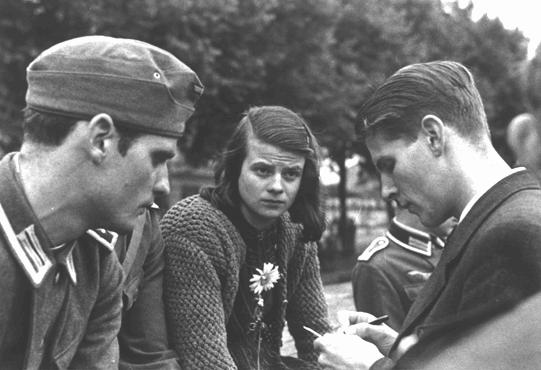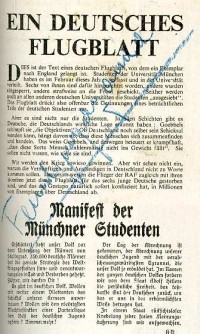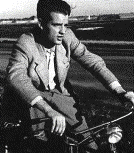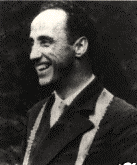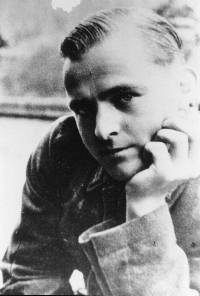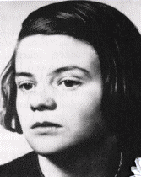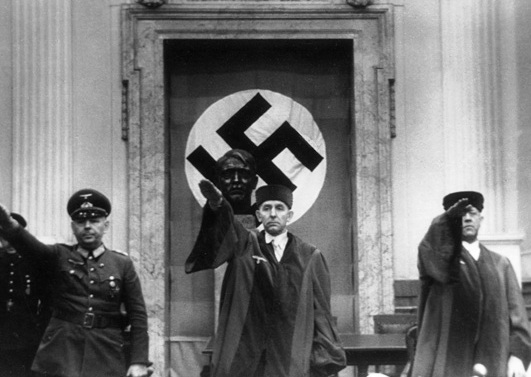Holocaust Education & Archive Research Team |
Revolt & Resistance
Acts of Resistance
Jewish Resistance
Groups Jewish Resistors Allied Reports Anti-Nazi Resistance Nazi collaborators
| |||
The White Rose
The White Rose
In the early summer of 1942, a group of young men — including Willi Graf, Christoph Probst and Hans Schol formed a a non-violent resistance group in Nazi Germany, consisting of a number of students from the University of Munich and their philosophy professor. The group became known for an anonymous leaflet campaign, lasting from June 1942 until February 1943, that called for active opposition to the Nazis regime.
The group co-authored six anti-Nazi Third Reich political resistance leaflets. Calling themselves the White Rose, they instructed Germans to passively resist the Nazis. They had been horrified by the behavior of the Germans on the Eastern Front where they had witnessed a group of naked Jews being shot in a pit.
Willi Graf was a member of Neudeutschland and the Grauer Orden. Neudeutschland is a catholic youth association. The group's members were motivated by their Christian beliefs. They had witnessed the atrocities of the war, both on the battlefield and against the civilian population in the East, and sensed that the reversal of fortune that the Wehrmacht suffered at Stalingrad would eventually lead to Germany's defeat. They rejected fascism and militarism and believed in a federated Europe that adhered to principles of tolerance and justice.
The Leaflets During early summer of 1942, Alex Schmorell and Hans Scholl wrote four leaflets, copied them on a typewriter with as many copies as could be made, probably not exceeding 100, and distributed them throughout Germany. These leaflets were left in telephone books in public phone booths, mailed to professors and students, and taken by courier to other universities for distribution. All four were written in a relatively brief period, between June 27 and July 12. As far as is known today, Hans Scholl wrote the first and fourth leaflets, Alex Schmorell participated with the second and third. . All leaflets were also sent to the members of the White Rose, in order that we could check whether they were intercepted. Significantly, of the first 100 leaflets, 35 were turned over to the Gestapo.
By turning the leaflets over to the secret police one hoped to be beyond suspicion. It might even have entered one's mind - and it certainly would not have been unthinkable - that such leaflets could have actually been produced and mailed by the Gestapo in order to test one's loyalty to the party and state.
The White Rose
Taking leaflets to other cities carried great risk, because trains were constantly patrolled by military police, who demanded identification papers of any male of military service age. Anyone traveling without official marching papers was AWOL - and the consequences predictable.
"Some of us traveled in civilian clothing, hoping for the best, some with forged travel orders, I myself used false identification papers (my cousin's with whom I shared a certain resemblance). We left the briefcases which contained the leaflets in a different compartment, for luggage was routinely searched. Mostly, however, leaflets were taken by female students who were not subject to such scrutiny."
While Hans and Alex alone drafted the first four leaflets, they counted on Christoph Probst to comment and criticize. Jürgen edited the third and fourth leaflets and traveled to Berlin with the dangerous documents. Willi contributed to the fifth leaflet and did a generous amount of leg-work, getting supplies and trying to recruit support outside of Munich.
Sophie worked at getting stamps and paper (one couldn't buy too many stamps at one place without arousing suspicion) and also managed the group's funds. Kurt Huber contributed to the fifth leaflet and solely drafted the sixth (and final) leaflet, while Hans was apprehended with a rough-draft of a seventh leaflet written by Christoph Probst.
All members traveled throughout Southern Germany (and beyond) to mail stacks of leaflets from undetectable locations. Hundreds of leaflets were also left at the University of Munich, carefully hand-delivered in the middle of the night.
Arrest of the White Rose
On three nights in February 1943 -- the 3rd, 8th and 15th -- Hans, Alex and Willi conducted the most dangerous of all the White Rose activities. The three men used tar and paint to write slogans on the sides of houses on Ludwigstrasse, a main thoroughfare in Munich near the University. They wrote "Down With Hitler", "Hitler Mass Murderer", "freedom", and drew crossed-out swastikas... this while policemen and other officials patroled the streets of Munich. It was, by far, the most public, blatant and dangerous of their activities.
On Thursday, February eighteenth, 1943, Sophie and Hans distributed the pamphlets personally at the university. They hurriedly dropped stacks of copies in the empty corridors for students to find when they flooded out of lecture rooms. Leaving before the class break, the Scholls noticed that some copies remained in the suitcase and decided it would be a pity not to distribute them.
They returned to the atrium and climbed the staircase to the top floor, and Sophie flung the last remaining leaflets into the air. This spontaneous action was observed by the custodian Jakob Schmid. The police were called and Hans and Sophie were taken into Gestapo custody. The other active members were soon arrested, and the group and everyone associated with them were brought in for interrogation. Sophie and Hans were questioned for four days in Munich, and their trial was set for February twenty second. They, along with Christoph, were arrested. Within days, all three were brought before the People's Court in Berlin. On February 22, 1943. The trial was run by Roland Freisler, head judge of the court, and lasted only a few hours, they were convicted of treason and sentenced to death. Only hours later, the court carried out that sentence by guillotine. All three faced their deaths bravely, Hans crying out his last words,
"Long live freedom!"
Later that same year, other members of the White Rose -- Alexander Schmorell (age 25), Willi Graf (age 25), and Kurt Huber (age 49) -- were tried and executed. Most of the other students convicted for their part in the group's activities received prison sentences.
Sources:
Students Against Tyranny: The Resistance of the White Rose, Munich, 1942-1943 White Rose, The (pamphlet) Franz J. Muller,et al., White Rose Foundation, Munich 1991 At the Heart of the White Rose: Letters and Diaries of Hans & Sophie Scholl Inge Jens, ed., Harper & Row, 1987
Copyright Carmelo Lisciotto H.E.A.R.T 2007
|
